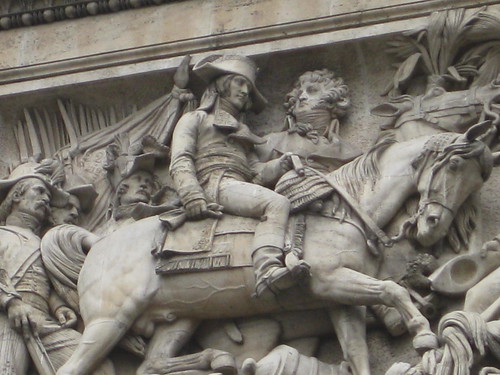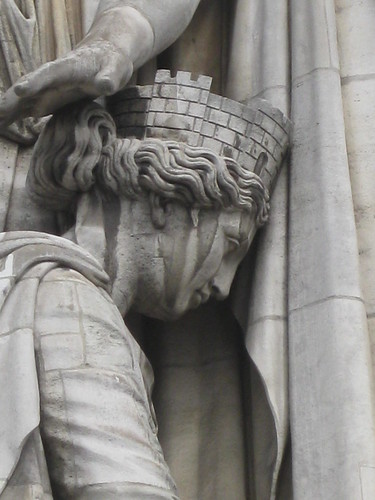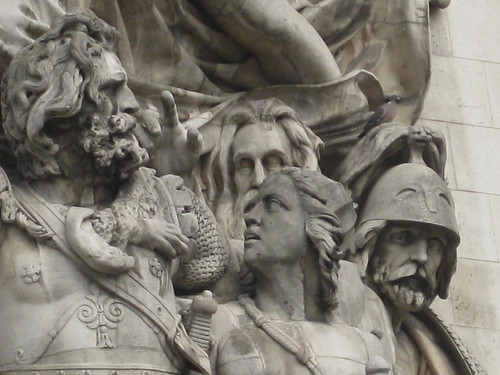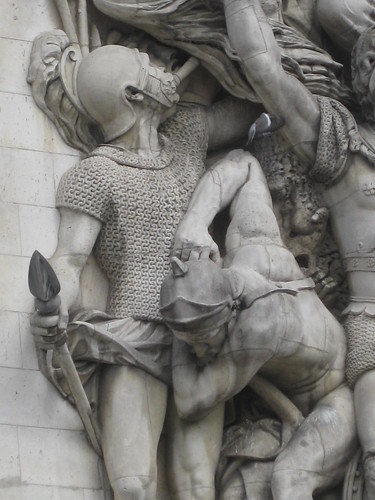
But have you really looked at it? How much do you really know?
Commissioned by Napoleon Bonaparte to commemorate his victory at Austerlitz in 1806, it followed typical French construction timetables, not being completed until well after the defeat and death of its patron. Sure, it was supposed to commemorate Napoleon's empire, but it wasn't finished until 1836, after the Bourbons were restored to the throne.
Eh, bien. Tant pis. Sure, the thing is covered with pro-Napoleon propaganda, but we'll just rename it in honor of the peace of 1815 and it's all good.
But take a look at the monumental sculpture! I had no idea it was so classical and beautiful. In fact, since we usually look at it from a distance, as in the photo above, it's easy to forget that there is more than just the arch. The sculpture panels and friezes are colossal.
At the top left of the arc is a large scale panel showing Napoleon accepting the tribute of his defeated enemies. NB sits atop a large white horse:

as the conquered bow.

Okay, only one guy is bowing, but he's actually kowtowing, so it all evens out.
Across from this panel, two monumental gods? heroes? Greek warriors? adorn the curve of the arch.


Below that, still on the left side of the arch (as you look at the first photo) is a tribute to Napoleon.

It gets better when viewed up close:
NB, dressed in Roman fashion, stands victorious (note the sword) as he is being crowned by Glory with the laurel wreath of antiquity:

(Naked boobs are okay, if they are classical. )
Meanwhile, his right hand gently hovers over the kneeling figure of defeated Europe, wearing a castle on her head to show his victory over kings and princes:

Let's get a close-up of that, shall we?

How that hand hovers, as if offering absolution and protection to the defeated!
Meanwhile, these deeds are being recorded by History!

Somehow I missed taking a close-up of the Angel Trumeting His Success To The World, although her toes are just above History's head, and you can kind of see her in the first photo of the grouping.
Quite the self-effacing guy, that Napoleon Bonaparte.
Realize, of course, that there is no real way to get a sense of the scale of this work if you are not actually standing beneath it. Here's my attempt to show some scale:

Random guy walking underneath one of the panels--he's a good six feet tall, and you can see the sculptures have to be at least 20 feet tall--or more.
On another leg of the arc, we have War calling:

and the warriors assembling:


In another tableau, we see the Righteous Warrior Protecting the Honest Peasants:

He's looking pretty noble. Above his head is this celestial being, who is ensuring that the Warrior can fulfill his Oath of Protection:

And here are the cowering victims of war, clinging to the promise of peace and stability offered by the Noble Soldier.

"Don't let them get me! I'm too old to die!"

"I tell you, babies can sleep through ANYTHING."
Now aren't you glad that Napoleon brought his army through your village or hamlet? You probably didn't realize that you were better off. Fortunately, there is this triumphal arch to let you know.
Finally, we have Prosperity Under Peace Triumphant:

We have the Secure Peasant, able to farm with a plowshare rather than fight with a sword:

Babies are fatter and healthier now, and children may now learn to read:

Our Mighty Soldier stays Alertly on Defense to protect this prosperity:

And the whole is watched over benevolently by Peace, which remains armored, though crowned with the victory laurel.

That's some serious propaganda that arch wields. Too bad by the time it was actually complete, Napoleon had been defeated, returned, was defeated again, Charles X and Louis XVIII had lived out their reigns, and King Louis-Philippe was due to be overthrown in twelve years' time.
But really, timeliness hasn't really been a huge concern for the French. They took their tribute to a repudiated Emperor, and turned it into a memorial for all the fallen of all the French Wars--World Wars I and II, Vietnam, Korea, and probably some others I have omitted. They have even added a Tomb of the Unknown.

It turns out it is also a nifty metaphor for the country itself. For you can climb the Arc de Triomphe and look out from its top.

If you look to the East, you can peer down the Champs d'Elysees (named after the eternal paradise of the heroes from Greek myth) down to the Louvre--the former grand residence of the Kings of France.

Look to the west, and an equal distance away stand the glass towers of modern urban commercial life.

Eternally poised between the riches of the past and the wealth of the future, the fulcrum of the balance between Now and Then--that's poetical. And very French.

No comments:
Post a Comment